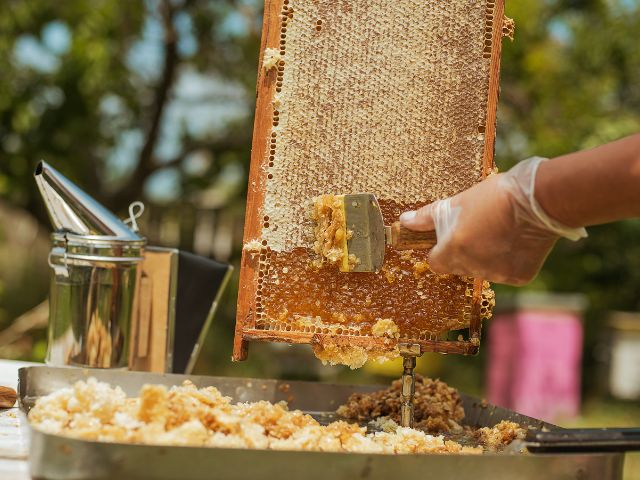
Harvesting honey from a hive is an exciting and rewarding activity, providing the sweet taste of success after a season of caring for bees. However, it’s not as simple as just pulling honey out; there are nuances to understanding before digging into the hive. For those taking the plunge into this sweet endeavor, here is what to know before harvesting hive honey.
The most important thing to do, and one of the most critical honey harvesting tips to learn, is to find the right timing. Honey harvesting isn’t a spur-of-the-moment activity. Waiting until the right time in a beekeeping season is essential. Check your hive’s nectar flow; if it’s ceased and the honey has less than 18 percent moisture content, it’s good to go! But keep in mind, if you do harvest too soon, you wind up with fermented honey with too much moisture.
Before harvesting begins, an apiarist inspects the beehive frames for capped honey. When the caps contain copious honey, that’s the bee’s way of telling you it’s “ripe” and ready to harvest. However, if your frame has uncapped honey-filled cells with moisture, then it’s not ready for harvesting.
Managing the bees during the harvesting process is paramount. There are various methods to gently encourage bees to leave the honey supers, including using a bee escape board or fume boards. The goal is to remove the bees without harm, ensuring the hive remains healthy and the bees aren’t overly stressed by the process.
Preparing for harvesting requires you to have the right tools, and it’s one of the most factual things to know for any part of beekeeping. From bee brushes gently persuading bees off the frames to extractors that spin the honey out of the comb, having the proper equipment at hand is a game-changer. Having the right equipment will turn every harvest into a delicious success.
In the pursuit of honey, always prioritize quality over quantity. It’s tempting to harvest as much honey as possible, but remember—the bees need sufficient stores to survive the winter months and to feed their offspring. A good rule of thumb is to leave at least one full deep box of honey for them to use in the winter and to nourish themselves and their larva.
Lastly, patience truly is a virtue when harvesting honey. Rushing can lead to mistakes, stress for both the bees and the beekeeper, and potentially lower-quality honey. Taking one’s time to extract and process the honey carefully pays off in the sweet, delicious results that make all the effort worthwhile.
While harvesting hive honey is an eagerly awaited task for any beekeeper, approaching it with knowledge, respect for the bees, and patience is essential. Understanding these key points ensures the process is rewarding and fruitful, yielding honey that’s as delightful to taste as it was to harvest. Prepare yourself for a successful harvest yield this beekeeping season.
24World Media does not take any responsibility of the information you see on this page. The content this page contains is from independent third-party content provider. If you have any concerns regarding the content, please free to write us here: contact@24worldmedia.com